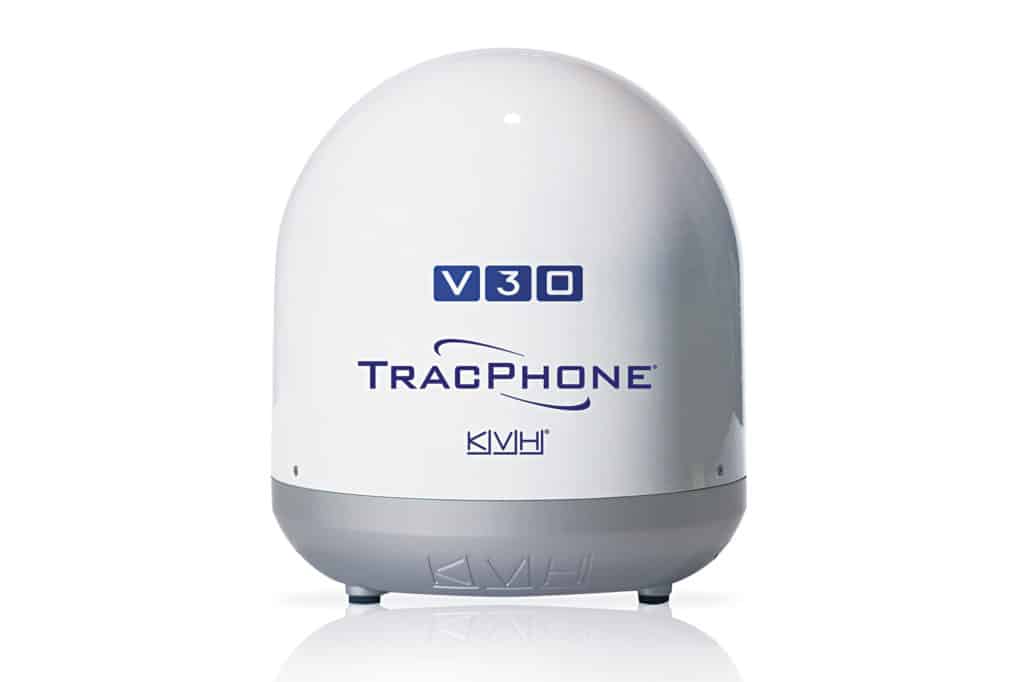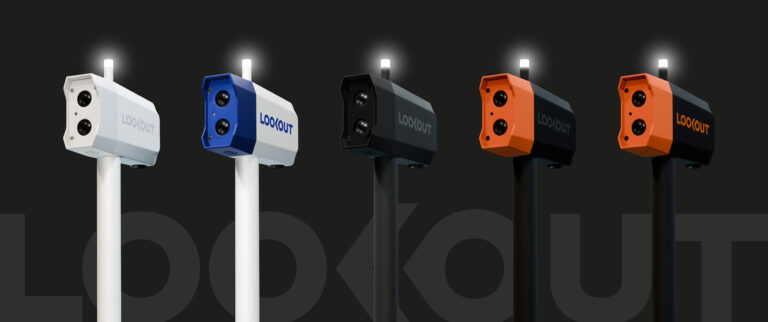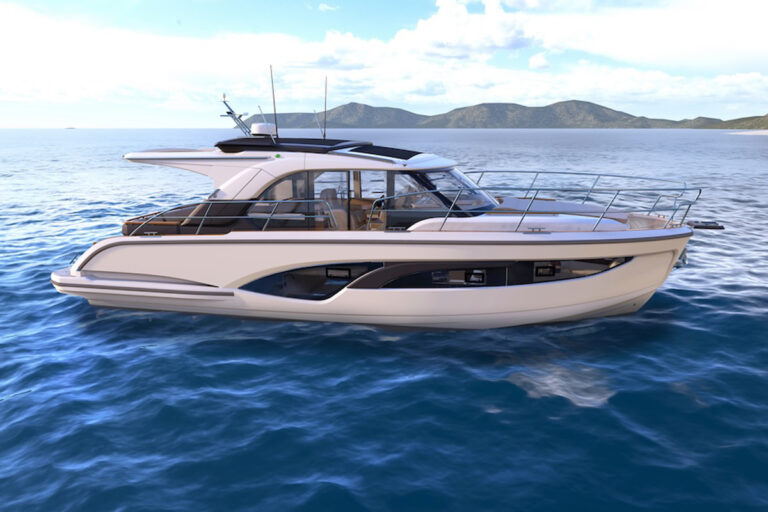
Massachusetts Bay, August 2004: Huge square waves and stiff headwinds were reducing our boat’s velocity made good toward Canada’s Bras d’Or Lake to fewer than 2 knots. We reconsidered our plans and took shelter at a mooring off nearby Provincetown to wait for a better weather window, complicating an already-complex travel itinerary.
My dad’s J/44 was loaded with electronics, but we didn’t have a satellite phone or even iPhones—a lack of technology that made sorting out logistics tricky. We got it done, but not before wishing that a small, lightweight, affordable satellite-communications system was available for DC-powered boats.
In recent years, VSAT (very small aperture terminals) satellite-communications systems have gained popularity as their antennas have become smaller and less expensive to purchase and operate. KVH’s latest VSAT system, the TracPhone V30, is the same size and delivers similar speeds as its predecessor, the TracPhone V3-HTS, while operating on KVH’s mini-VSAT BroadbandSM network. However, the TracPhone V30 has new architecture and bolstered cybersecurity features, is priced at one-third less, and consumes DC power, allowing it to be fitted aboard smaller vessels.
The TracPhone V30 uses a 37-centimeter antenna dish that’s housed inside a radome measuring 15.5 inches wide by 17.6 inches high. It weighs 23.4 pounds. The antenna is stabilized across two axes, which allows the system to articulate its dish elevation from 7.7 degrees to 75 degrees while delivering unlimited azimuth rotation. Unlike KVH’s previous-generation VSAT systems, which have rack-mounted belowdecks modems, the TracPhone V30′s ($11,995) ruggedized modem is inside its radome, allowing KVH to spec a small belowdecks VSAT hub.
In terms of power needs, the TracPhone V30 uses 10 to 36 volts of DC power, allowing it to be fitted aboard center-consoles, sailboats, electric craft and vessels that don’t carry generators (AC-to-DC power converters are available). Power is sent to the TracPhone V30 across a single 50-foot Ethernet power-over-coaxial cable that also transports data.
“When we started the project, the number-one request was for DC power,” says Robert Balog, KVH’s chief technology officer.
TracPhone V30s send and receive data over Ku-band frequencies at speeds up to 6 megabits per second for downloads and 2 Mbps for uploads. This is an ample pace for making phone calls, running enterprise software, downloading GRIB weather files, web surfing, streaming high-definition content, or participating in Microsoft Teams or Zoom video calls.

Like all KVH VSAT systems, the TracPhone V30 operates exclusively on KVH’s mini-VSAT BroadbandSM network. While KVH customers can’t shop for cheaper airtime plans, they do get hardware and software engineered for the company’s global network, as well as tech support that can address hardware and network concerns.
“We offer two types of plans: metered and unlimited,” says Jim George, KVH’s director of satellite sales, adding that most customers opt for unlimited plans. “Metered plans cost 50 cents per megabyte and are for customers who use their boats on the weekends and want to stay connected.” As an example of usage, Teams meetings typically use about 1 megabyte per minute.
Alternatively, KVH offers six unlimited plans from $150 to $3,000 per month for 200 megabytes up to 10 gigabytes of data at (or near) the system’s top speeds.
“Once a customer hits their data limit, the system changes to slower speeds,” George says. Customers aren’t charged for additional data use, but their speeds are down-throttled once they cross their data thresholds. Customers can change their airtime plans any time and can winterize their plans during the off-season.
Irrespective of the airtime plan, KVH’s network-management toolsalso allow customers to control data usage. For example, networked wireless devices can be restricted from consuming background data, and customers can set data-usage alerts.
The TracPhone V30′s architecture, Balog says, is KVH’s antenna architecture for the next decade. “Satellite throughput on the V30 is 6/2 Mbps [downlink/uplink], but we’re running a 1,000 Mbps [EPOC] cable, so we’re ensuring all sorts of different things,” he says.
Down-the-road applications could include faster data-transfer speeds—should KVH upgrade its network—Internet of Things products, and transmitting networked NMEA 2000 data to third-party clouds for maintenance and performance monitoring. KVH already internally monitors its antennas’ data. “Every three seconds, the antenna [transmits] engineering data that tells us exactly how the antenna is performing,” Balog says. “We can look at coverage problems and, for example, show customers the mountains that are blocking their signal.”
This new architecture also means the system’s belowdecks VSAT hub can have a built-in Wi-Fi router, obviating the need for third-party devices to share connectivity with networked devices.
While future-proofing is a big reason that KVH created the TracPhone V30, so too is cybersecurity. “It’s absolutely jampacked with state-of-the-art cybersecurity,” Balog says.
In addition to architecture and cybersecurity, the TracPhone V30′s one-cable design is intended to simplify installation. It uses the same bolt pattern for the radome as older 37-centimeter KVH systems, Balog says. While TracPhone V30s ship with 50 feet of EPOC cable that’s terminated at both ends, customers can buy a KVH cable-adapter kit and reuse existing cable, say, from an old Inmarsat FleetBroadBand terminal.
As with all small VSAT systems, the TracPhone V30 may leave users encountering bandwidth issues if multiple people are streaming simultaneously or running video calls. “The V30 is perfect for email,” George says, adding that owners wanting to stream lots of content should consider a bigger antenna.
So, for those shopping for a small, DC-powered primary VSAT system—or a backup antenna for a bigger yacht—and who want the ease of bespoke hardware created for an end-to-end network, KVH’s TracPhone V30 can help take business and life interests aboard.









